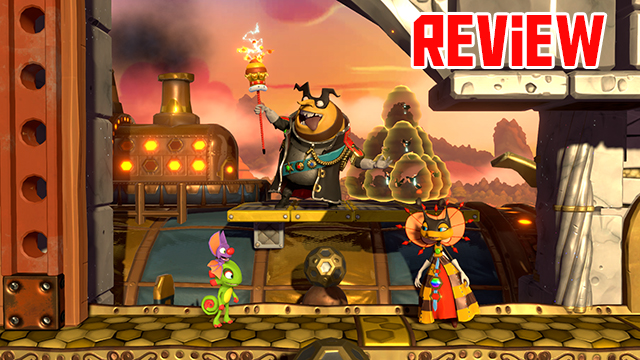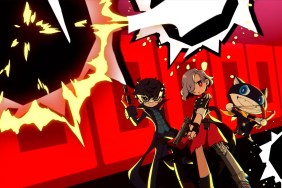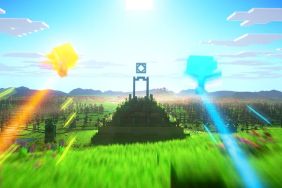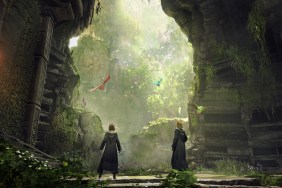Yooka-Laylee is a marquee example of misguided nostalgia as the Kickstarted throwback ended up being a boring, dated 3D platformer that couldn’t hang with the current genre stars. To combat that tepid reception, Playtonic squished the series down into 2.5D and more closely chased after Donkey Kong Country over Banjo-Kazooie with its latest game, YOOKA-LAYLEE AND THE IMPOSSIBLE LAIR. Losing half of a dimension was a wise choice in many regards as it builds a better game around that style but it lacks some of the precise controls needed to fully bring it into the modern platformer era.
Although it’s not archaic in every aspect as it has quite a few elements that add to rather than directly borrow from the established platformer formula. Instead of a static hub world that serves as a glorified menu that lets you choose stages, The Impossible Lair’s map plays out more like a 3D adventure game that is littered with puzzles and secrets.
ALSO: Every Nintendo 64 game that needs to be a part of Nintendo Switch Online
Solving these puzzles and finding these secrets requires enough thinking to be engaging but not so much to actively stop you from advancing. Solutions aren’t too obtuse and serve as an effective means to break up the pace from all the jumping and rolling in the platforming levels.
Figuring out these short cerebral tests even enhances those levels, too, as they tie directly into how the game creatively handles its progression. There are around 20 or so stages peppered around the overworld but that number is effectively doubled given how the game repurposes each stage through puzzles in the hub.
Yooka-Laylee and the Impossible Lair Review | A tale of two levels
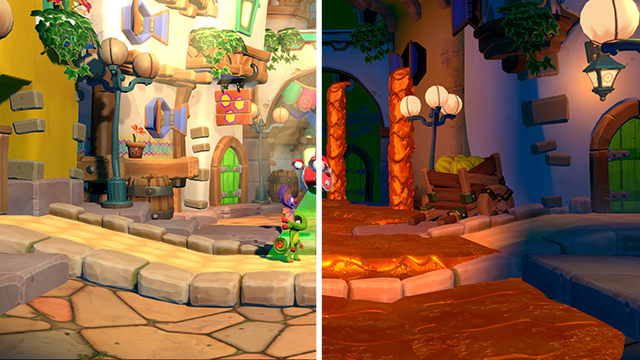
Pouring honey into the saw blade level portal in the hub will turn it into a sticky mess with alternate paths and hazards inspired by the aforementioned bee goop. And as that example shows, it goes up and beyond merely making uninspired fire and ice versions of each world. Thoughtful remixes of every stage are doubly rewarding since they efficiently extend the game’s life without superfluous padding and become worthy rewards for solving the overworld’s puzzles. These puzzles are inherently valuable for their pace-changing properties and light challenge but more so given how they directly improve the game and unlock more meaningful content.
Whether drenched in honey, filled with ravenous creatures, or beaming with high-powered lasers, each core stage is a delight to look at and listen to as they have the same qualities, despite the difference in mediums. Lush colors fill every corner of the screen and are aided by the title’s charming art direction that’s a retro callback in all the right ways. Every level has the same vibrant palette of hues, yet executes that tone in different ways, resulting in a cohesive style that changes just enough to stay fresh.
The cheery visuals are only topped by its complementary soundtrack. Similar to the colorful art, each composition is heartening mix of sounds that are all different from each other but feel like they’re part of the same tonally consistent album. Famed ex-Rare composers Grant Kirkhope and David Wise (along with Playtonic’s internal composers) have created a list of earworms that are equally as infectious whether you’re playing a regular level or its altered B-side. Anticipating what visual splendor awaits you in every stage only pales to each’s glorious tune that’s easily worth listening to once you’ve put down the controller.
Yooka-Laylee and the Impossible Lair Review | Controls stickier than honey
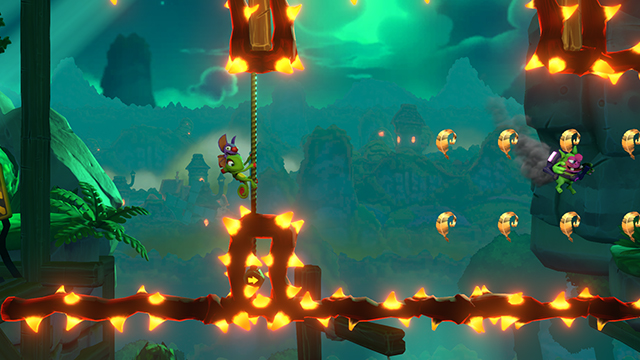
Playing the game, however, is not quite as consistently rewarding because of the its passable controls. “Passable” means they’ll usually get the job done, but platformers, given their precise nature, demand a level of responsiveness that not every genre requires. Despite its smooth and steady frame rate, Yooka-Laylee and the Impossible Lair sits somewhere in the middle and that divide is where the classics separate from rest. And the “rest” is where the Impossible Lair’s controls put it.
Jumping, attacking, and rolling are functional and can shine in the easier levels that don’t call for much accuracy. But as the difficulty ratchets up, the controls can’t always support that stress because they feel like they were directly transplanted from the duo’s 3D debut. 3D platformers inherently move differently than their 2D genre siblings as both have their own unique standards. After all, the Mario in Super Mario Sunshine doesn’t quite maneuver in the same way that the Mario in New Super Mario Bros. does.
The Impossible Lair throws more intense hazards at the player but still maintains the floatiness and momentum of the 3D title. You’ll slide around a little more than you mean to (especially after a roll) and jumps can be hard to nail because of its loose controls. Underwater levels and icy surfaces only exacerbate these weaknesses, which make a swimmy game even swimmier and a slippery game even more slippery, respectively. Modern 3D or 2.5D platformers appear to rely more heavily on physics systems and a few of them suffer because of it. It’s why the Crash Bandicoot N. Sane Trilogy feels slightly off when compared to its PS1 originals. The Impossible Lair is just not as tight as it needs to be and the game is not entirely built around its limitations, especially given all the frequent, random lapses in polish keep you from moving forward and pile on top of the control issues. The camera might obscure threats or glitch out, Laylee can fly out of bounds, or something else equally unfair can happen and stack the odds against you in ways that feel cheap and undeserved.
Yooka-Laylee and the Impossible Lair Review | A moveset that has moved backwards
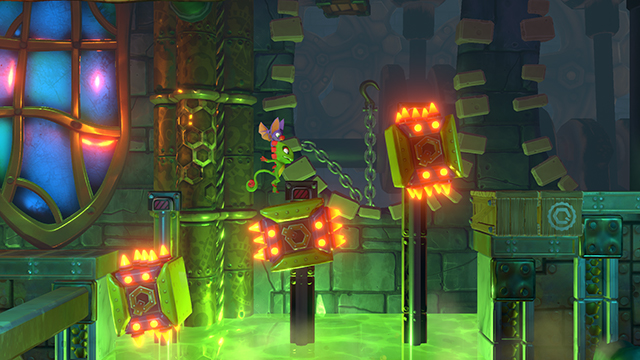
Some of the blame can be pinned on the limited moveset. Yooka can jump, tail whip, roll for a few feet, and hover for a second. There are no mandatory upgrades or much in the way of progression so your core Yooka in the beginning is the same reptile at the end. Not every game needs to have new abilities but they would help give the game variety and smooth other its aforementioned complications.
Or, at least, they would help. An actual glide would help you land more reliably on platforms. A double jump could get you out of more sticky situations. Both would grant you more ways to escape death and correct your mistakes on the fly while also injecting some variety into the game. As it stands, you’ll often know you’re going to die well before it happens because you just don’t have the tools to dig yourself out of trouble. While different games call for different abilities, it’s peculiar how many moves didn’t jump over from its spiritual predecessor; useful moves that would have been quite welcome here.
Tonics do attempt to give the game some upgrades but they are inherently faulty. After you track a Tonic down, you have to spend Quills — the breadcrumb-like collectible — to buy them. But all of the ones you’d want to use, like a better float or improved speed, subtract how many Quills you can earn at the end of a level. And you’ll need Quills to progress in the main game and buy these Tonics. Draining your wallet by essentially taxing what you earn and taking what you have bleeds you at both ends and makes it difficult to want to use any of the useful ones that could keep you from advancing the campaign.
Yooka-Laylee and the Impossible Lair Review | An aptly titled lair
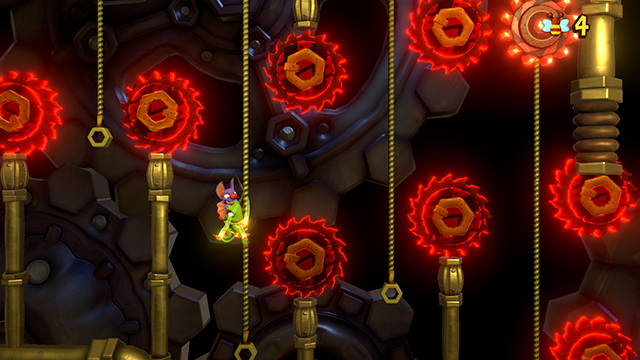
These misguided assists aren’t even usable in the game’s last challenge, the titular Impossible Lair, which is where all of its shortcomings are magnified exponentially. Instead of a steady ramp up to this climactic finale, the difficulty skyrockets without properly preparing you in the preceding stages first. Halls of saw blades, tons of pits, tight jumps, and more make up this 30-minute gauntlet that you have to clear in one life while also fighting the controls that don’t contain the necessary finesse.
Clearing the game’s core levels gives players more hit points for the Impossible Lair, but that still does not address how poorly it prepares them for this sudden challenge and how inadequate its controls are to suit it. Because of these oversights, it’s an exhaustive endurance run of ridiculous obstacles that look more like a secret endgame level or something out of those hellish viral Mario Maker montages meant for sadists. Throwing this at the end of the critical path is as befuddling as it is infuriating.
Yooka-Laylee and the Impossible Lair ends on a puzzlingly frustrating note that heightens its most egregious errors that consist of its imperfect controls and stymied progression system. The botched finale doesn’t make those stumbles any more forgivable and mainly just points them out, but that doesn’t undo its positive qualities. The crafty world design and resourceful double level layouts are highlights that hold up the experience alongside its catchy, superb soundtrack. After the huge whiff last time around, Yooka-Laylee and the Impossible Lair is undoubtedly an improvement — a small one, but an improvement nonetheless. But an improvement doesn’t guarantee greatness and this game makes that clear.
GameRevolution reviewed Yooka-Laylee and the Impossible Lair on PS4 with a copy provided by the publisher.
-
Sublime, upbeat soundtrack that never gets repetitive.
-
Inventive level design.
-
Remixed stages cleverly and efficiently double its size.
-
Controls are too floaty and imprecise.
-
Progression is mostly absent except for the tonics that penalize you.
-
The titular Impossible Lair has a ridiculous difficulty spike.
